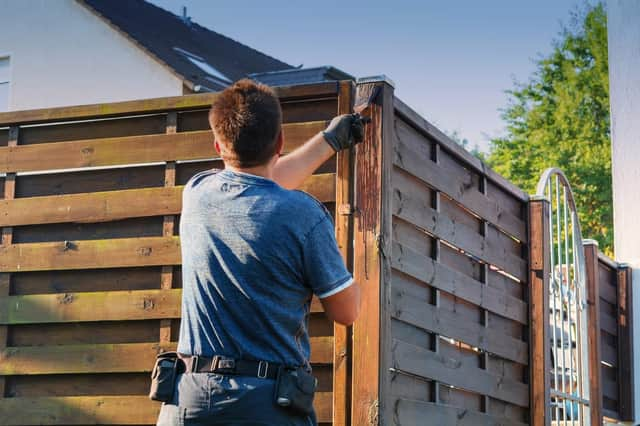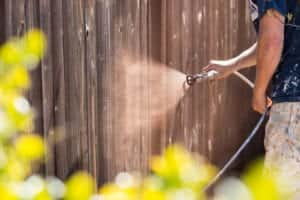Here are 9 top tips for painting your fence, including when to do it, and which tools to use


Like mowing the lawn and other seemingly banal household tasks, painting a fence is actually much more nuanced than it would first appear.
Sure, you could slap on a single coat of wood paint haphazardly and hope for the best, but you'd be doing your fence a disservice.
Advertisement
Hide AdAdvertisement
Hide AdWith enough time and effort, your fence can be maintained to a high quality for a surprisingly long time with a good painting.
Plus, the activity of painting the fence might just be the kind of low-energy, low impact job you need to take your mind off things right now.
Here are 9 tips to getting it right
Paint your fence during the warmer months
It’s advised that you check the weather forecast at least 24 hours before committing to taking on the task of painting a fence.
Warm, dry conditions will allow the paint to set and dry better. Too cold and the paint won’t dry, and you’d hate for the rain to come along and ruin your efforts just after you’ve finished.
Dry conditions above 5°C are recommended, and you’ll want to paint onto a dry fence too.
Then again, too hot and the painting also won’t work properly; wait until the fence is in the shade before you start work otherwise the paint may will dry too quickly and won’t soak into the wood properly, which won’t allow proper protection.
Brush or sprayer?


Choosing the right tool for the job is paramount.
Obviously, the first thing that springs to mind is getting your hands on a brush, but painting large sections of fence by hand can take a lot of time and patience.
If you want a quicker job, you could opt for a power sprayer, but be warned you’ll need to look out for paint that is specially formulated to work with these kinds of tools.
Advertisement
Hide AdAdvertisement
Hide AdAnother word of warning for the use of pumps and sprayers: don’t use them on windy days. You only have to imagine the kind of painty carnage that could cause.
Even if using a sprayer, you’ll likely need a brush to finish off corners and reach those slightly trickier bits.
A wide brush at least 100mm/4” will cover surfaces quicker, while a smaller 25-50mm/1-2” brush will help you fill in any awkward gaps.
Protect your plants
Before you start work on your fence – and particularly if you are using a sprayer – you’ll want to make sure any plants and vegetation are protected by covering them in plastic sheeting.
If required, trim back any of the foliage to give yourself space to work, and invest in some plant ties and canes if any plants are still resting on the fence panels and can’t be covered or cut back; you’ll be able to pin them back temporarily.
Clear your fence completely
Old nails or screws and hanging baskets or decorations will certainly get in your way while painting your fence, so you’ll want to clear them away before you get started.
Once that’s done sand down any rough areas or splinters sticking out of the panels; smoother panels make for a better finish.
Apply a layer of primer
This isn't going to be a one coat job.
Apply a layer of primer to all the panels and let it dry completely. Not only does this give a better finish, it will increase the length of protection afforded by your paint.
Applying your chosen colour
Advertisement
Hide AdAdvertisement
Hide AdNow you can begin to paint the fence panels with your selected colour, using the tool of your choice.
Use horizontal strokes for horizontal panes of wood, and vertical strokes for vertical panes; follow the direction of the wood's grain for a smoother finish.
Apply the paint well
Don’t be stingy on the amount of paint you apply to your fence.
You want to make sure it fully penetrates the timber for the best protection, so don’t be scared to slap it on.
Do make sure to catch any drips though; a good tip is to start at the top and work your way down catching globules of paint as you go.
Stay safe


Painting a fence might seem like a pleasantly serene chore (even a bit tedious in the eyes of some!), but it’s fraught with danger.
Stay safe while painting your fence:
- avoid eye splashes by wearing goggles, and change into old clothes or invest in a disposable suit to protect your clothing
- wear appropriate gloves; tough ones for sanding, impermeable gloves for water-based paints and solvent-resistant gloves when handling solvent based products
- when preparing the fence, wear a dust mask to avoid the inhalation of unwanted particles – you may also want to wear a mask while painting to avoid fumes
- take care if using a ladder, making sure to wear appropriate shoes
- if you get paint on your skin, wash with warm soapy water straight away; if you get paint in your eye wash with clean, warm water
Finishing up
Once you’re all done (making sure you’ve got to every last inch of your fence with paint), it's time to clear up.
Remove any plastic coverings from your plants, and released any unfortunate foliage from temporary ties, though do make sure the paint is dry before you do this, as getting paint on your plants could damage them.
Advertisement
Hide AdAdvertisement
Hide AdLook after any brushes you’ve used too – clean them as soon as you’ve finished to preserve them.
If you’ve used an oil-based paint, you’ll need some white spirit to clean brushes properly as it’s thicker than water-based paint.